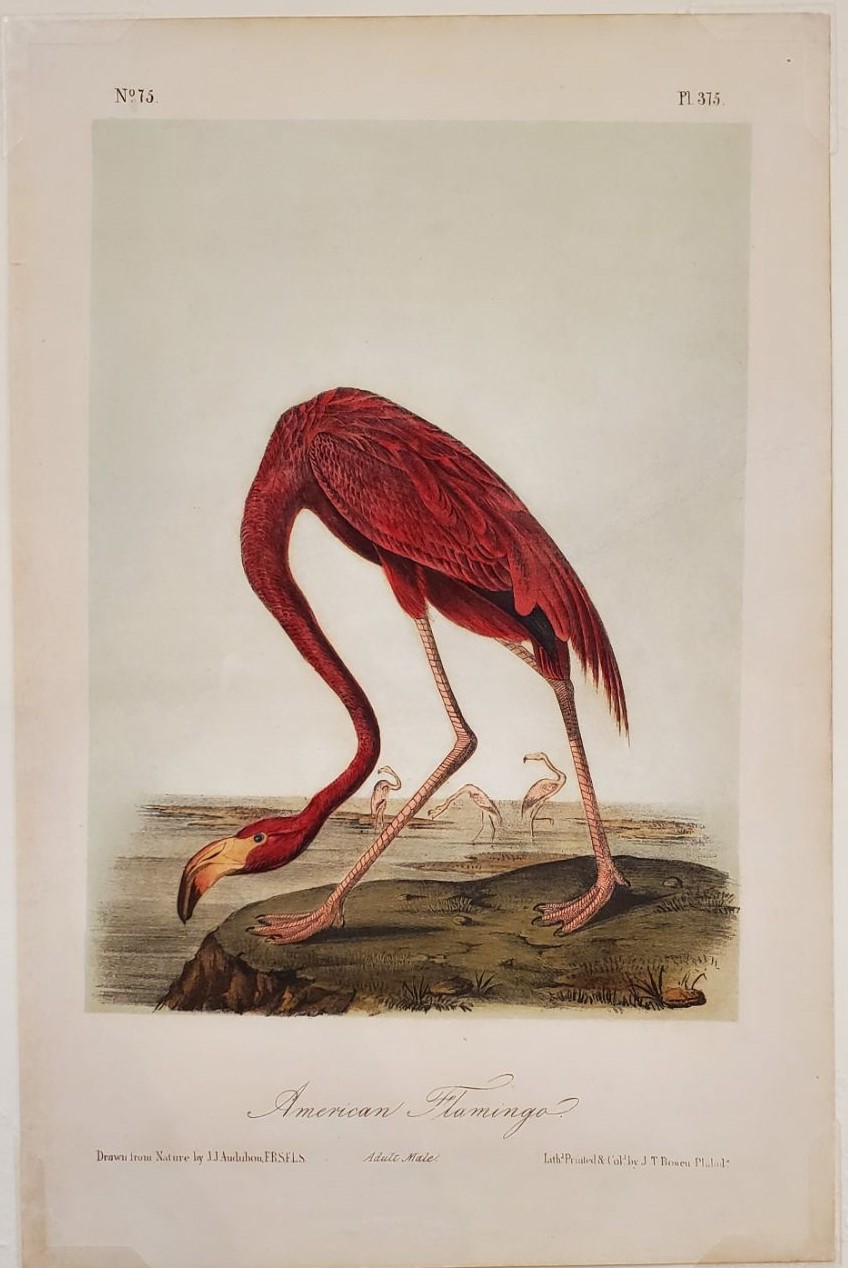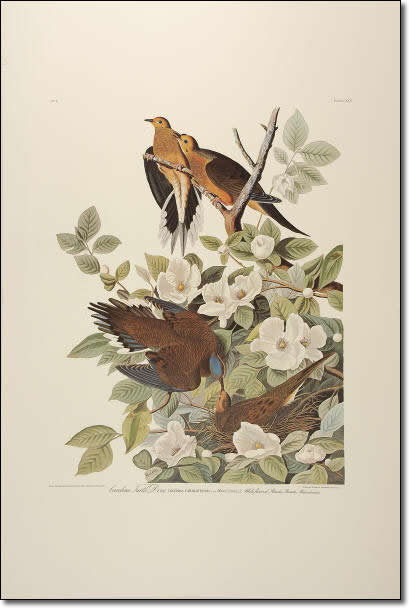The artwork created by John James Audubon represents the finest natural history illustrations ever made. His art is grand, elegant, and inspiring to behold. The “Birds of America” is considered the finest book to ever be produced. However, there is much mystery surrounding the process by which the prints were designed, and what constitutes an original Audubon versus a reproduction. With this introduction, we hope to explain some of the details of the various editions.
Editions
Audubon editions can be generalized into two categories:
- Original engravings and lithographs
- Modern reproductions or facsimiles
Original Audubon Prints
Double Elephant Folio
Between 1826 and 1838, John James Audubon worked with Robert Havell, a London engraver to create the “Double Elephant Folio”. Audubon’s “Great Work” was called the “Double Elephant Folio”, the “Birds of America” or the “Havell Edition”. The name Double Elephant was a printer’s term regarding the size of the paper. This was the largest format paper available for printing in the early nineteenth century. Double Elephant sized paper measures approximately 26 inches by 39 inches. Audubon used this large format paper to accommodate his drawings, which were actual life size. The paper used in this original edition bears a watermark of the paper manufacturer, J. WHATMAN, and the year that the paper was created. There is an additional watermark on some of the engravings that reads “Turkey Mill”. These watermarks are only visible when the paper is unframed and not mounted to backing. To identify a Havell engraving, the actual paper can be held up to a window, or another source of light and the watermark will appear. It is on this large format, Whatman paper, that Robert Havell engraved the artwork of John James Audubon. These are all hand colored copperplate engravings that were created at the engraving studio belonging to Robert Havell in London.
There were approximately 175 folios created of the Birds of America, each with 435 different images of birds depicted. They were issued to original subscribers in lots of five, over the course of several years. It took over a decade to complete the publication, and once a subscriber had all the works in their possession, most subscribers had them bound in to a very large, four volume set.
Royal Octavo Editions
John James Audubon created the Royal Octavo Edition in order to make his work more affordable and more widely available. Measuring 10¼ inches by 6¾ inches, the paper was one- eighth of the size used in the Double Elephant Folio. The Royal Octavo Edition was published by J. T. Bowen of Philadelphia, starting in 1840. Utilizing a camera lucida, Audubon reduced the large scale images to a one- eighth scale, which were then transferred onto lithographic limestone, a reusable and less expensive material than the copper of the Havell engravings. Some compositional changes were made in order to accommodate the octavo edition, but most exhibit meticulous fidelity to the larger works. Like the Havell Edition, the Royal Octavo Edition was sold by subscription, issued five prints at a time. All Royal Octavo plates bear a plate number in the upper right corner, and a shipment number in the upper left corner. The first edition of approximately 1,200 sets was completed in four years, between 1840 and 1844. The second edition, comprised of approximately 1,000 sets, was finished in 1856. The third edition was completed in 1859, and then Lockwood purchased J. T. Bowen’s lithography studio, and produced editions through 1871.
Complete original sets were typically bound in seven volumes, and also contain the Ornithological Biography, Audubon’s field notes regarding each species that he painted.
Imperial Folio Quadrupeds
In the years 1845 through 1848, John James Audubon created “The Viviparous Quadrupeds of North America”. It is comprised of 150 different images of mammals, and is commonly referred to as the “Imperial Folio”. It was also sold by subscription, and published in three volumes each with 50 plates each. The first volume was completed in 1845, the second volume in 1846, and the third volume was completed in 1848. They are all stone lithographs that were created at the J.T. Bowen studio in Philadephia. These images were created by John James Audubon with the assistance of his two sons, John Woodhouse and Victor Gifford. Also assisting the Audubon men was the Reverend John Bachman, who was a naturalist painter as well. The Imperial Folio Quadrupeds measure approximately 22 inches by 28 inches outer dimensions.
Royal Octavo Quadrupeds
John James Audubon’s son, John Woodhouse, greatly assisted with the painting of the Quadruped Edition. He did nearly half of the original paintings. John Woodhouse Audubon then reduced all of the Quadruped images for the Royal Octavo edition. John James Audubon’s other son, Victor Gifford assisted with the artwork for most of the landscape and botanical backgrounds. The lithography and printing was done at the J. T. Bowen lithography studio in Philadelphia in 1854. The second edition was completed between the years 1851 – 1855. The edition contained 155 hand colored plates, and the paper measured 7 inches by 10¼ inches. These were also sold by subscription, with 31 different parts, with 5 plates per part. In addition to the 155 hand colored images, subscribers received text pertaining to the mammals painted, and then all of the text and images would be bound into a 3 volume set. There is no visible difference between the editions.
Julius Bien Edition
After John James Audubon’s death in 1851, his sons, John Woodhouse and Victor Gifford Audubon sought to reissue The Birds of America. In 1858 they commissioned Julius Bien of New York to print an edition similar in size to the Havell Edition using the new technique of chromolithography. The plates were renumbered to correspond with the numbers of the octavo edition, and some were changed by grouping birds or changing backgrounds. Because of the financial and social upheaval of the Civil War, the project was never completed. Only 150 plates were ever completed. Estimates of the number of prints produced vary from 15 to 100. The Bien Edition were lithographs produced from stone plates but instead of printing a black line image from a single plate which was then individually hand colored (like the octavos) the chromolithographic process utilized several plates, each applying a different color ink. These prints offer the collector a chance to own one of the earliest color prints produced in America.
Quadrupeds Editions
| Edition | Dates | No. of Plates | Size (Inches) |
|---|---|---|---|
| Imperial Quadrupeds Editions | 1843 – 1865 | 150 | 22 x 28 |
| Royal Octavo Quadrupeds Editions | 1849 – 1870 | 155 | 7 x 10½ |
| Southart-Parkway Edition | 1980s | 12 | 21 x 28 |
| Oppenheimer Field Museum Edition | 2002 – now | 50 | 22 x 28 |
Modern Audubon Reproductions
Amsterdam Edition
In 1972, a special limited edition of 250 complete folios of the original 435 plates was printed in Amsterdam, the Netherlands. They were sold by subscription in complete sets, subscribers could choose to receive the sets bound or unbound. The Amsterdam Edition are multicolor offset press reproductions of an original complete folio owned by the Teyler’s Museum in Haarlem, the Netherlands. The Teyler’s Museum purchased their folio in 1839. The paper mill G. Shut & Zonen (founded in 1625) manufactured the paper for this edition using 100% unbleached cotton rag, and the paper bears the watermark from the manufacturer. To verify the authenticity of an Amsterdam Edition print, one would hold an unframed print up to a window, or other light source, and the watermark will appear that reads “G. Shut & Zonen”. The watermark is not visible while the artwork is framed. Amsterdam Edition prints are full size, 29½ by 39½ inches.
Princeton Edition
The Princeton Audubon collection is unique in the world of Audubon art. It is a series of direct camera facsimile lithographs. Production of the Princeton Edition began in 1985, using original Havell engravings. By utilizing a process called “direct transfer”, Princeton publishers were able to create one of the finest and most accurate Audubon reproductions ever accomplished. The printer used up to eleven colors of specially designed inks on very heavy, acid free museum paper which was toned to match the average color of the original Havell copperplate engravings. Princeton Audubon prints are sized at 26¼ by 39¼ inches. Individually pencil numbered and embossed with the Princeton seal denoting authenticity, these outstanding prints are editions of 1,500 and 500.
Essex Edition
One of the newest editions that we offer is the Princeton Essex Edition. Measuring 19 inches by 23 inches or 17½ inches by 26 inches, this edition represents a “half size”. Princeton Audubon paired with the New York Historical Society to create these beautiful reproductions. The use of specially made colorfast inks pressed upon the finest of all paper, 110 pound Essex, assures the collector a most accurate reproduction. Essex paper is produced at Monadnock Paper Mills in New Hampshire. The Princeton Essex collection has been issued in limited numbers, with 2500 as the typical edition size. They are all pencil numbered along the lower left edge of the image.
Oppenheimer Editions
Oppenheimer Editions offers high quality, limited edition facsimile editions from the world’s finest natural history artists. The publisher has partnered with a variety of institutions to offer the collector faithful giclée reproductions of the artwork of John James Audubon, and many other artists. Oppenheimer Editions partnered with the Field Museum of Natural History in Chicago to offer “Audubon’s Fifty Best”, a collection of the top fifty images that John James Audubon produced. This edition offers 50 images, limited to 150 numbered sets, each stamped, numbered, and signed by the Field Museum Librarian on the back. Each print is on Somerset velvet, an acid free, cotton, watercolor paper imported from England. Oppenheimer Editions also produced an edition in cooperation with the New York Historical Society, called “Audubon’s Fifty Best Watercolors”. The Oppenheimer-New York Historical Society Edition recreates the watercolors that Audubon made prior to the publication of the double elephant folio Havell engravings of “The Birds of America”. This lovely edition is printed with watercolors on imported archival English watercolor paper, and is limited to 200 complete sets.
Heritage Edition
Published in conjunction with the Teyler’s Museum in Haarlem, the Netherlands, the Heritage Edition is the newest edition that we offer. Containing all 435 Audubon’s Birds of America, this is a great edition to source some of the less accessible images. These are high quality, Giclée reproductions, strictly limited to 250 copies. They are signed, numbered, and blind embossed. The Heritage Edition is original Double Elephant size, measuring 26½ by 39 inches.
Birds Editions
| Edition | Dates | No. of Plates | Size (Inches) |
|---|---|---|---|
| Havell Edition (Double Elephant Folio) | 1826 – 1838 | 435 | 26½ x 39 |
| Bowen Royal Octavo Editions | 1840 – 1871 | 500 | 6½ x 10¾ |
| Bien Edition | 1858 – 1860 | 150 | 27 x 40 |
| Amsterdam Edition | 1971 – 1973 | 435 | 28 x 39 |
| Leipzig Edition | 1972 | 40 | 27 x 38½ |
| Abbeville Edition | 1985 | 435 | 28 x 39 |
| Alecto Edition | 1985 | 6 | 26½ x 39 |
| Princeton Edition | 1985 | 36 | 26¼ x 39¼ |
| Loates MasterEdition | 1992 | 10 | 19½ x 27 |
| Oppenheimer Field Museum Editions | 1999 – now | 50 | 26 x 39 |
| Audubon House Edition | 2005 | 21 | 6½ x 10¾ |
| Essex Edition | 2006 | 4 | 19 x 23 or 17½ x 26 |
| Heritage Edition | 2010 | 435 | 26½ x 39 |




